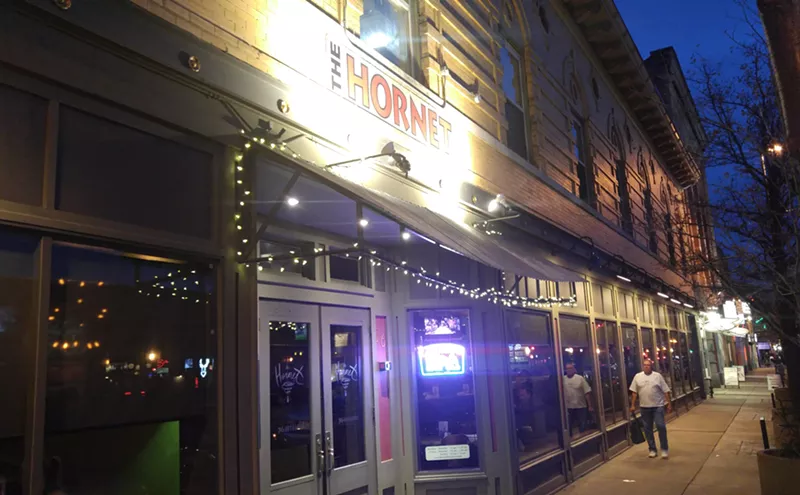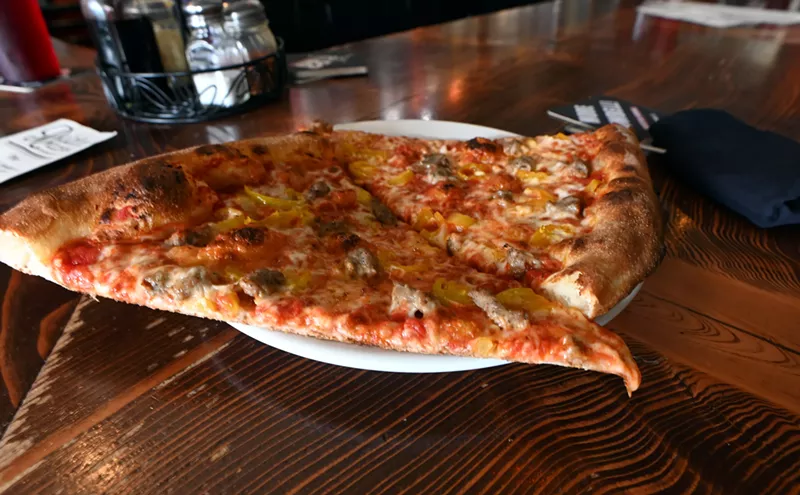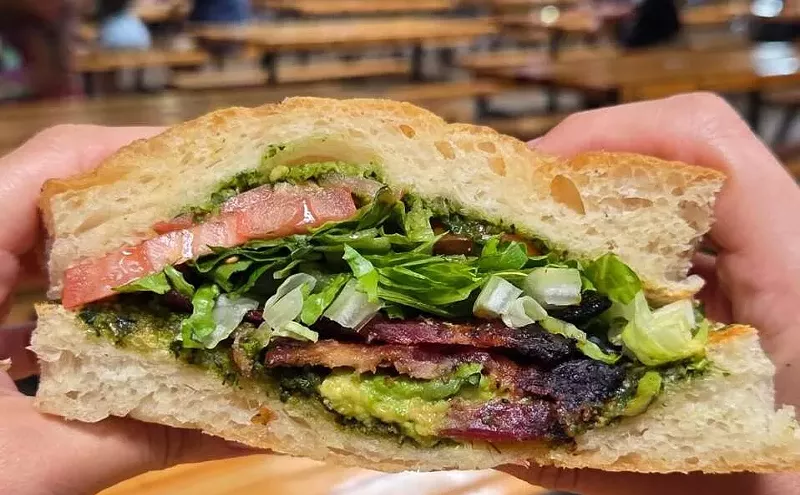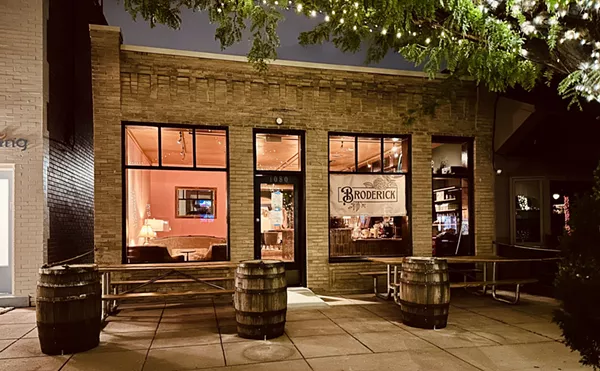I must have missed the scene in Like Water for Chocolate where Tita lovingly takes a fistful of frozen Costco taquitos, caresses them sensuously, dampens them with her tears, then drops them into the hot fat of the family Fryolator. It's certainly possible; Christ knows I slept through most of the movie.
But I can't miss those lines -- erratic capitalization and ugly grammar included -- written in smudgy cursive script inside the saffron-colored menu at Julia Blackbird's New Mexican Cafe. And while I'm standing there reading them, out of the corner of my eye I see one of the cooks in the big, center-island show kitchen pull frozen taquitos out of a bag and unceremoniously dump them into the fryer basket. That's love right there, I think. That's the pure, unbridled passion of cooking straight from the heart, no doubt. Just seeing it makes me smile, because it's not often that you get such a fast return on your belief in the essential bullshit of the restaurant industry. Talk to me about tradition, about love and Earth and the sustenance of the spirit, then serve bagged, frozen antojitos hecho en Costco. The irony is precious.
When the waitress comes to seat me, she must think I'm a little slow because of the size and plain joy of my stupid grin.
"Just one for lunch?" she asks, a little hesitantly.
"Absolutely," I say, giving her the full wattage of my happy heart and justified cynicism.
The four-year-old Julia Blackbird's recently moved down the block from its cramped original home on 32nd Avenue, and in these more spacious surroundings, it does an admirable job -- of being a theme restaurant. That's exactly what this place is, no better or worse on the sliding scale of food-service operations than any faux-'50s chrome-plate diner or Midwest simulacrum Japanese hibachi restaurant. Only here it's howling-coyote New Mexican. Julia Blackbird's works off that same retread Miami Vice earth-tone yellow and orange color palette that the tourist restaurants in New Mexico use; has the same sort of blocky, bright, Picasso-esque nuevo-traditional art on the walls, rigidly following those acceptable native themes of quasi-cubist portraiture and depictions of chile-picking and corn-growing. There are tacked-on, adobe-style architectural flourishes to the design of the interior and incredibly uncomfortable straight-backed rough-wood chairs, obviously handmade, probably by authentic native craftsmen who believe in the authenticity of discomfort, and deliberately mismatched with equally unpleasant modern furnishings. The space looks and feels exactly like the New Mexico seen by tourists -- not the poverty-stricken, Third World reality of the place, but the charmingly brown-skinned, crystal-wearing, "It's a Small World After All" Disney version, full of art and piñon trees and Indian turquoise Kokopelli jewelry for sale in the gift shop.
Like Santa Fe, in other words. Or most of Taos. Which is what I figure owner Julia Siegfried-Garrison was going for, and the Nebraska native hit it right on the nose. Hers is a New Mexico for rich white yuppies, where the closest you get to anything authentically Mexican (of the New or old variety) is the guys in the kitchen touching your food. Perfect for Denver, double-perfect for the Highland neighborhood.
And not only is the space an authentic replica of, say, the Atomic Cafe or the Zia Diner in Santa Fe, or anything in Old Town 'Burque, but so is the food. As you eat your way through the plazas or downtowns of these tourist burgs, you come to learn that the food is, at best, a watered-down version of the true abuelita cuisine of the Land of Enchantment, made pretty in an attempt to turn a chicken breast, squash flowers, a little corn smut and some hominy into a plate worth $14.95 to any out-of-town yokel with a fat wallet and a sunburn. Real abuelita cuisine (the stuff that real New Mexicans really eat) is itself a cultural translation, a mix of Amerind and borderlands Mex which, in turn, is only another version of the pueblo cooking that's been around forever. So by the time this food makes it to Denver, it's already a copy of a copy, at least four times removed from any actual cultural history, and it tastes that way -- not exactly loveless (because with the amount of precision that goes into Julia Blackbird's imitation, I know there's some honest, if misguided, passion there), but certainly superficial. All wispy Eros, no nasty lust.
Like Water for Chocolate -- the title itself being a particularly poetic Spanish euphemism for "horny" -- is all about sex and death, longing, and food as a method for getting to do the hibbity-dibbity with your sister's husband. Heavy on the innuendo, this is not lightweight stuff -- and using it on the menu was Julia's idea, not mine. But the kitchen doesn't deliver. Arriving at the table are endless examples of love thwarted, of passions hampered, of lust undone. The tri-color chips come straight from a bag. The chile con queso is described as "an intimate blend of cheeses and chile," but I can get just as much love out of the nacho pump at 7-Eleven. And the salsa is a sweet-hot purée of tomatoes, lacking both the swift fire and slow burn of a great salsa and even the texture of a mediocre one. It tastes like it was made with a half-dozen ripe tommies, a pepper mill and a nine-iron.
The calabacitas are a knockoff: sliced squash, corn, onion and garlic with a steam-table soul. The Navajo stew claims to include "everything holy in New Mexico" -- beans, hominy, squash, corn, chiles and (inexplicably) potatoes -- but fails to include the turquoise, brushfires, Trinitite, lowriders and brown reservation ditch weed that are just as vital to life in the real New Mexico as any corn goddess or plate of pintos and chile. Julia's Famous Posole speaks for itself with a menu description of unerring accuracy, promising "hominy and tender pork kissed with robust ground red chile" and delivering exactly that. This dish is a tease: a kiss with no tongue, a chaste and sisterly peck on the cheek with nothing behind it but sterile affection. There's comfort but no fire here, fondness but no fervor. The soft hominy and tender pork, the gentleness and simplicity of the posole's mild flavors, duplicate the one-note flatness and banal allure of Disneyland New Mexican flawlessly. In its original incarnation, posole is the mulligatawny, the cioppino, the pho and seige coddle of Mexican cuisine. It's a benchmark dish, an everything-in-the-pot riot of slow-cooked flavor and heat. It's a lot of things, but harmless never one of them. Julia's Famous version is not bad, just forgettable -- and good posole should never be that, either.
But then, like New Mexico itself, which can sometimes stun you with its raw beauty or charm you with unexpected kindnesses, Julia Blackbird's serves a few dishes that sneak up when you're not looking and remind the tongue what the heart always knew -- that no place that's trying as hard as this can possibly botch everything. On the visit when I smile over the frozen taquitos and sigh over the far-from-famous posole, I suddenly get a plate of piñon chicken that's so good I can't stop eating and would eat a second if it were put in front of me. And a third. The magic is all in the sauce, a silky-smooth piñon concoction with layers of smoky, earthy flavor, complex backbeats of chile and a blunt sweetness that's bright like unrefined piloncillo sugar, but also as indistinct as the chocolate in a masterful mole. The hito is a marvel, too -- a paillard of marinated pork loin swimming in another beautiful glossy sauce, the grill-char and dull sugars and gentle warmth all working together to create a dish good enough to make me forget the wrongs done in this dining room.
And then there's Julia Blackbird's green chile. This is New Mexico green, not Colorado, and the verde -- in total contravention of almost everything else I experience here -- operates on a biochemical level indistinguishable from the endorphin rush you get in any true New Mexican taquería. The kitchen roasts and skins its own Chimayo chiles -- which are slightly milder and sweeter than the Hatch breeds but pack a distinctive cumulative wallop that'll have the sweat beading up under your hair by about the fourth bite -- and shows admirable restraint in not getting overly fussy with the pods. That this green chile has such respect for the Chimayo's high, fruity sweetness and depth of flavor is testament to the fact that someone in the house knows when not to mess with a classic -- but why that skill and depth of understanding disappear when it's time to make the queso, I have no idea.
To me, the menu continues, food is so much more than just eating. When I cook for you, I am sharing with you a part of myself. Feasting and exchange of food reflects the depth of common ideals of reciprocity, community, and the relationship to all life. Food is life.
And on that, finally, Julia Siegfried-Garrison de la Blackbird and I are in total agreement. Food is life, is love, is passion and commitment and pain and heartache. I firmly believe that what a cook is feeling while he works or while he writes his menus is translated into the food that he serves, and the problem I have with Julia Blackbird's is that what's being felt -- and therefore transmitted from kitchen to customer -- is a feather-light and insignificant kind of affection, a two-bit romance-novel version of love among the creosote bushes, passion muffled under a blanket of flirting cuteness.
This restaurant's interpretation of New Mexico is not the New Mexico I knew and loved and lived in. It offers little more than a nickel tour through a sightseer's paradise and all the flavors you'd get from licking a tour-bus window.












